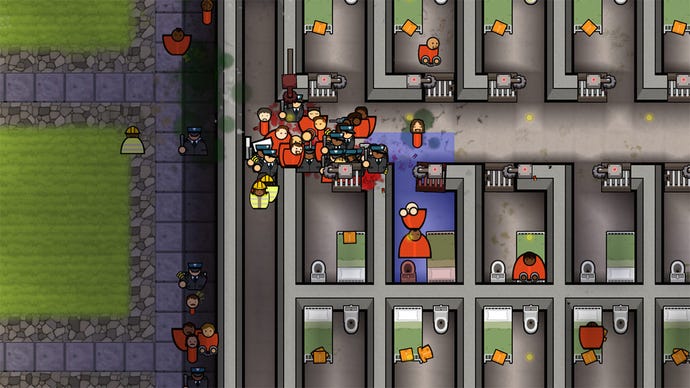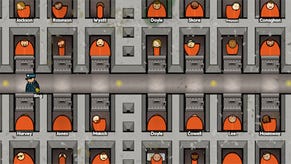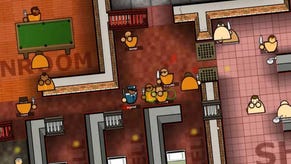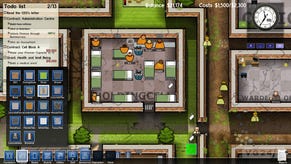Prison Architect PS4 Review: Sim Penitentiary
Run your own prison in this complex, yet engaging simulation.
This article first appeared on USgamer, a partner publication of VG247. Some content, such as this article, has been migrated to VG247 for posterity after USgamer's closure - but it has not been edited or further vetted by the VG247 team.
Prison Architect is exactly what it says it is: A simulation that lets you build and run your very own prison. Originally released on Steam late last year, the top-down game has been converted to PS4 and Xbox One, and it's surprisingly entertaining.
I say "surprisingly," because I initially had doubts about how a fairly complex PC simulation would translate to the more simple and straightforward controls a console offers – but this game does work quite well. Sure, it can get a little fiddly at times working your way through its myriad of menus and options, but generally speaking, the console version of Prison Architect manages its complexities quite well, all things considered.
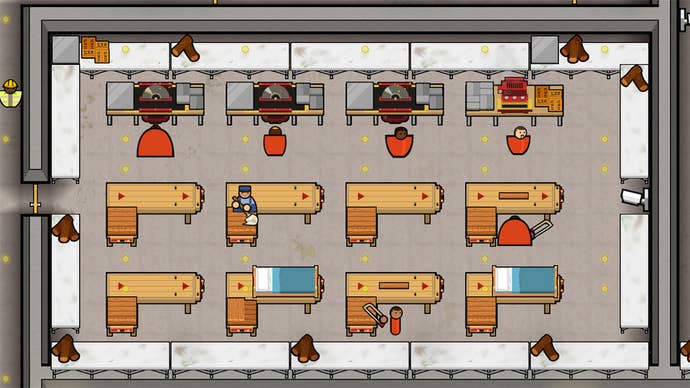
That's largely due to the very comprehensive tutorial mode, which takes the form of a series of five "prison stories." Each one packs several different challenges that essentially get you up to speed on different aspects of the game, starting with a set of building projects. The story in this case tells of a prisoner who's been charged with double homicide and sentenced to death. The problem is, the prison doesn't have an electric chair or the facilities to look after the condemned man. This is where you learn how to make a building, install various fixtures like a bed, window, and toilet, and put in flooring. And, of course, ensure that you build an execution chamber, complete with electric chair.
That's all easy enough, but then you need to ensure that the chair is hooked up to the electricity supply, and that the prison generator is capable of handling the load that the chair puts on it. Which means installing new electric cabling, and adding extra capacitors to the power generator. This is the kind of minutiae that makes Prison Architect such an interesting and in-depth simulation. It features plenty of this kind of detail, allowing you to run your prison at a very macro level, from dealing with garbage through plumbing your buildings with water to assigning guards to specific areas and setting up patrol routes. Indeed, Prison Architect is quite overwhelming in terms of its depth, which is why it's really important to play through its tutorial mode before you start building your own prisons.

The second chapter in the prison stories mode covers emergency services, prisoner needs, and rebuilding. This starts with putting out a fire that's raging across a couple of buildings (which involves managing the firemen who arrive to deal with the blaze), and then rebuilding a new kitchen and canteen so that the prisoners can be fed. Again, you get to manage pretty much every aspect of the build, and it's quite satisfying watching your workforce install everything from cookers and refrigerators to garbage bins and tables.
At this point, I was finding the proceedings easy to digest, and felt pretty confident going into the third chapter, but this is where the difficulty begins to spike. This time, you're dealing with a prison riot, which you have to get under control; a challenging task that involves managing squads of prison riot guards, and then setting up regular guards to go in and essentially keep the peace. Even with the excellent instructions, I struggled a bit here, and it took a while for me to regain control of the prison and set up enough guards in the right places to stop smaller riots from breaking out again. I built a morgue and an infirmary to take care of the injured and dead, and generally did everything I could to restore law and order – and eventually did after some trial and error.
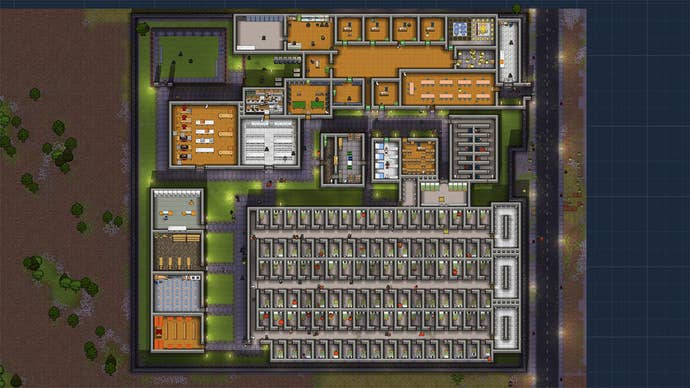
It was at this point that I felt I was probably ready to try my hand at designing my own prison. It turns out that I wasn't really, but fortunately you can tweak the game settings to make things very easy for you (or very difficult, if you want). I turned off a bunch of different options, such as prison gangs being active, and made sure that I had unlimited funds to build my dream prison. I started out small, constructing a few basic cellblocks, and then expanded with recreation rooms, a kitchen, and canteen.
What was interesting was following my prisoners' behavior. They have needs, and you can decide whether or not to meet them. Since I had unlimited funds, I tried my best to keep them as happy as possible – I built a big laundry so they could have clean clothes often, and a common room where they could hang out and read books and watch TV. I even went as far as installing TVs in each prison cell to try to keep my inmates entertained. At one point it felt almost like I was planning a hotel.
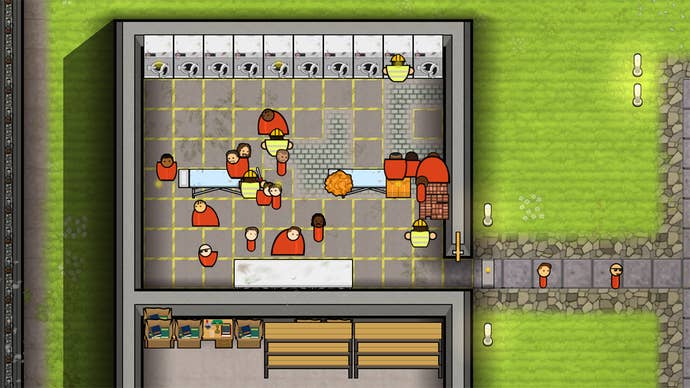
But then, this is the beauty of Prison Architect. It's an incredibly broad and deep sandbox game that lets you play it in a wide variety of ways. You can run your prison like a business, building everything frugally, and packing in prisoners to make plenty of profit. Or you can run it like a model prison like I tried to, keeping everybody happy with everything they could possibly want.
Here's the thing, though. No matter what you do, there's always a challenge. For me, even running a prison where everyone's needs were met, prisoners still got into trouble. I also had a problem with staff becoming exhausted – and contraband coming into the prison because I was being too soft on the inmates. At least, that certainly seemed to be the case. So I dialed up security with shakedowns and more guards, which cured the problem for a while – but didn't make the prisoners particularly happy. But even that didn't solve my problems – no matter what I did, something always came along that required my attention, including inmates digging tunnels and trying to escape, shankings to deal with, fights, fires, and even riots when I got too heavy-handed with my guards' regimen.
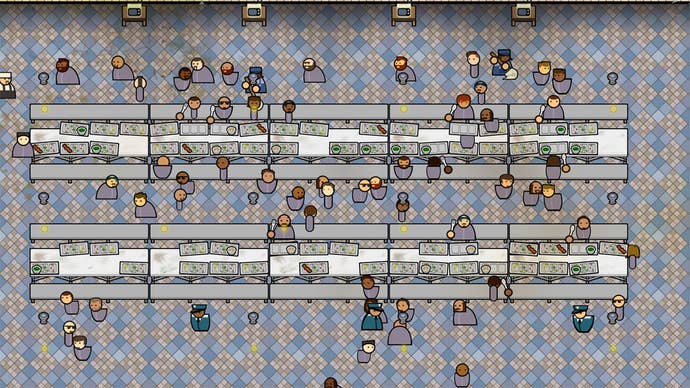
Ultimately, there seem to be a lot of different systems in this game that are designed around checks and balances, and it's pretty much impossible to get everything right all of the time. And even if you get close, some random event comes along to mess things up. However, it doesn't feel forced – there's a logic to the game that makes sense: Things happen for a reason, and it's up to you to solve them. It all helps make Prison Architect a fascinating experience – a weird ant farm of a game that needs constant ministrations to keep it running smoothly.
For those who enjoy detailed and complex building games, Prison Architect is a solid buy. It mightn't be the best-looking game out there, and the sound is quite basic, but it offers a depth of gameplay that's really laudable. If you want to take the plunge, do bear in mind that despite having a good tutorial, it doesn't tell you everything there is to know about the game , and you'll very likely have look up certain aspects of it online to get an understanding of how they work. In that respect, Prison Architect requires you to put in a fair bit of work to really get the best out of it, but if you do, you'll be rewarded with a deep, entertaining, and surprisingly addictive building/simulation game.
Lasting AppealPrison Architect is a very deep and broad game that has plenty of potential for long-term play, whether you're building prisons from scratch, or using existing templates.
SoundSimple sound effects generate a basic prison atmosphere.
VisualsThe game's stylized graphics won't win any awards, but they're effective.
ConclusionThis port of the popular PC prison-building game has been nicely executed to deliver a deep and compelling experience on consoles. Its complex menus and mechanics present a fairly steep learning curve, even with the game's effective tutorials, but once you get over it, Prison Architect is a challenging, entertaining, and surprisingly addictive game that offers plenty of potential for long-term play.
